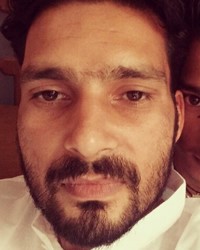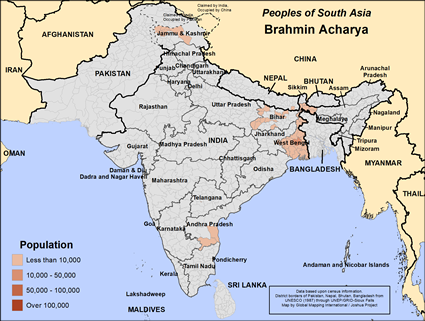Brahmin Acharya in India

Photo Source:
Anonymous
|

Map Source:
People Group data: Omid. Map geography: UNESCO / GMI. Map Design: Joshua Project.
|
| People Name: | Brahmin Acharya |
| Country: | India |
| 10/40 Window: | Yes |
| Population: | 74,000 |
| World Population: | 74,000 |
| Primary Language: | Bengali |
| Primary Religion: | Hinduism |
| Christian Adherents: | 0.00 % |
| Evangelicals: | 0.00 % |
| Scripture: | Complete Bible |
| Ministry Resources: | Yes |
| Jesus Film: | Yes |
| Audio Recordings: | Yes |
| People Cluster: | South Asia Forward Caste - Brahmin |
| Affinity Bloc: | South Asian Peoples |
| Progress Level: |
|
Introduction / History
The surname Acharya or Acharyya is a Brahmin sub-caste (jati) whose main occupation was educating and teaching the sacred texts of Hinduism. Acharya is also a title, honorific or upadhi given to spiritual teachers. They are sometimes referred to as a sub-caste of warrior Brahmins. Some well-known mythological mentions are Dronacharya and Kripacharya from the Mahabharata and Shukracharya from Ramayana.
Acharyas are considered upper caste and have been able to take advantage of education and job opportunities and other human resource development services or infrastructure. During the British Raj, owing to their reputation as upper caste and educated, Brahmins took advantage of Western education and job opportunities in the colonial state.
The sacred thread is common for all men of Brahmin and other Dwija or twice-born castes. The specific prayer items used by the Acharyas are determined by the type of ritual, the state that they live in, and their linguistic community. For example, rituals and prayer items of Bengali Acharyas will differ slightly from the customs and artefacts of Tamil, Odiya or Tripuri Acharyas.
They are primarily located in the Indian states of West Bengal and Bihar, but they also have pockets in Andhra Pradesh and Kashmir.
What Are Their Lives Like?
In India, caste and class may or may not intersect, meaning Brahmins may be economically wealthy but this is not always the case. They are not considered a disadvantaged caste in India.
They still have good educational opportunities which give them a big advantage in the job market. Acharyas are found in many occupations including academics and research, music and arts, engineering, medicine, government administration, etc. In West Bengal, their occupation is not necessarily strictly dictated by their caste.
Traditionally they had practiced caste endogamy and gotra (clan) exogamy like other castes. Today such caste rules are relatively lax, an effect of modernization, secularization and urbanization among other possible factors.
What Are Their Beliefs?
Acharyas practice Hinduism which is an umbrella term for a diverse belief system. Depending on the state and the local sub-caste or jati structure, they may have different beliefs, practices, customs and rituals. Generally, rituals they practice include the birth ceremony, sacred thread ceremony, marriage rituals and funeral rites.
Hindu temples play a central role in their spiritual lives, serving as places for worship and community gatherings. They also emphasize the study of sacred texts, including the Vedas and Upanishads, which guide their spiritual and moral principles.
What Are Their Needs?
They need to put all their faith in Jesus Christ so he can be free to give them the abundant life he offers those who follow him. As it stands, Jesus is hardly on their radar screen.
Prayer Points
Pray for a spiritual hunger that will not be satisfied until they meet the Risen Christ. Pray that gospel materials will lead them to discovery Bible studies. Pray for the Lord to thrust out the right people as Christ bearers to the Acharya Brahmin community.